Posts Tagged ‘placemaking’
Posted on: May 7th, 2012 by Waterloo Region Crime Prevention Council
The first weekend in May has quickly become known as Jane’s Walk weekend. That’s when thousands of people from neighbourhoods around the world join up with friends to take in free guided walks offered in their town or city. People get a chance to learn something new, discover a new part of their city, meet new (or existing!) neighbours and get in touch with the environment. Jane’s Walk helps neighbours and residents feel more connected to their community. WRCPC believes that a more connected community is a safer community. That’s why we got out and walked and encouraged the whole city to walk with us!
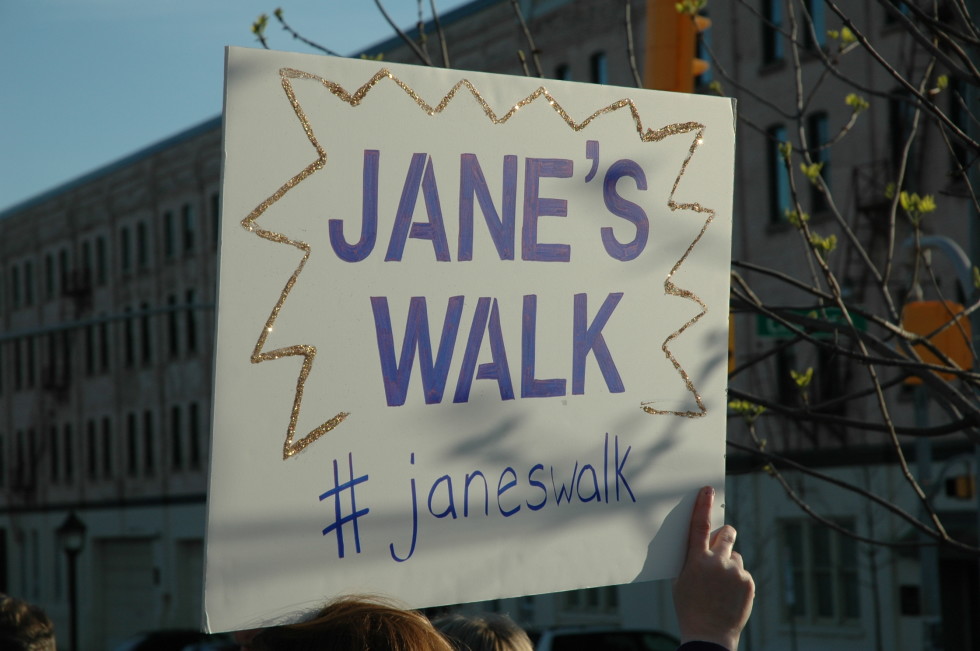
Jane’s Walk is in honour of Jane Jacobs, an urbanist and activist whose ideas came to prominence in New York in the early 1960’s. Her observations and writing were in response to city building that focused on car-centric development that effectively cut people off from each other, their neighbourhoods and their sense of place. Jane Jacobs believed that vibrant, dynamic, healthy and safe places need a sense of connection and that local residents must be involved in their own neighbourhood and city development. Jane Jacobs’ ideas of the city as an ecosystem have influenced generation of planner, architects, politicians, activists and citizens, just like you and me.
Jane Jacobs believed in connection to place – connection and knowing a place intimately cannot be done by looking at models and inventing dream cities, rather, Jane would say, “You’ve got to get out and walk!” She would say you’ve got to get to know you place – get to know it’s history, what and who has shaped it, how it is changing, what works well, what doesn’t work… who lives there and what might be its potential for the future. And that’s exactly what we did on our Jane’s Walk on May 5th. We brought together neighbours and residents to explore, discuss, ponder about possibilities and test out new perspectives.
The theme of our Jane’s Walk this year, lead by the Safe and Healthy Advisory Community Advisory Committee of Kitchener and the Waterloo Region Crime Prevention Council, focused on what makes a neighbourhood or street feel vibrant, dynamic, safe and healthy. We used the ‘Power of 10‘ – a concept developed by the Project for Public Spaces (PPS) to shape our walk. The Power of 10 is the ideas that every city or town has 10 identifiable destinations/districts. Each district has 10 places within it and each place has 10 things to do around it. When a place does this successfully, ten or more things or activities create an energy that is easily felt and identifiable.
Ten things might include places to sit, food, snacks and beverages, history to experience, music to hear, a playground to enjoy, art to touch or experience, people to meet, information to read, a green space or natural feature and walking/cycling trails or access to public transit.
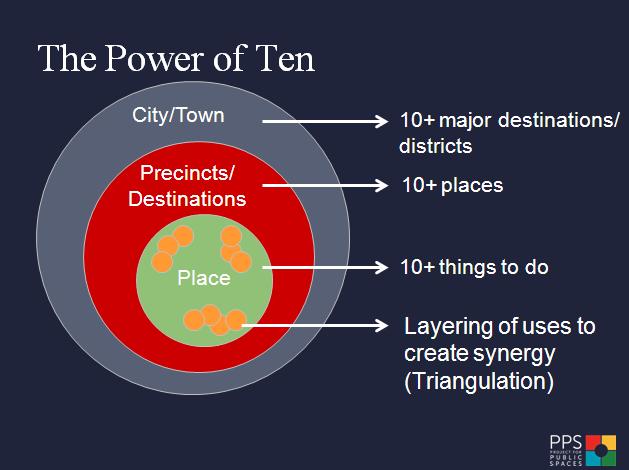
http://www.pps.org/reference/the-power-of-10/
During our walk of Downtown Kitchener, we examined 4 places that are identified & promoted as major places within the downtown district. We visited The Tannery (in the newly named Innovation District), Victoria Park, Market Lane & the Kitchener Market area, and the Centre in the Square. Each location prompted a lively interaction about its merits and what might improve the dynamics and vibrancy of some places that seemed to be lacking.
You might be wondering what this has to do with “smart on crime” or “crime prevention” or “safety”. Both PPS and Jane Jacobs would agree that the way a physical space is designed, promoted, maintained and managed has an impact – positive or negative – on the type of activity that happens in a place. Places that have a multi-purpose usage at varying times of the day and night and includes and engages a diversity of people, tend to be more vibrant, dynamic, safe and healthy place. Essentially, if we can reduce the likelihood of crime occurring and reduce the fear of crime through physical design and increased dynamic activity, that’s a pretty smart approach to crime prevention.
The four places we visited got mixed reviews on their success as a ‘great place’ with 10 or more things to do around them. Although, Victoria Park was clearly a ‘great place’ where people could easily identify 10 activities in close proximity. I invite you to go visit the four places and decide for yourself! Let us know what you think.
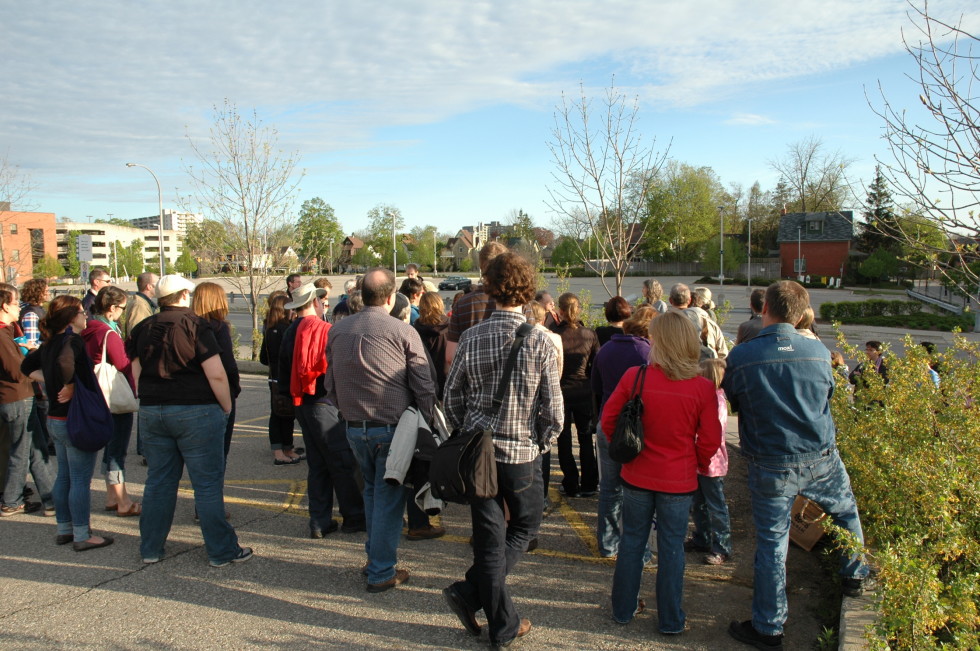
A crowd gatherings at The Tannery in the spring evening sun.
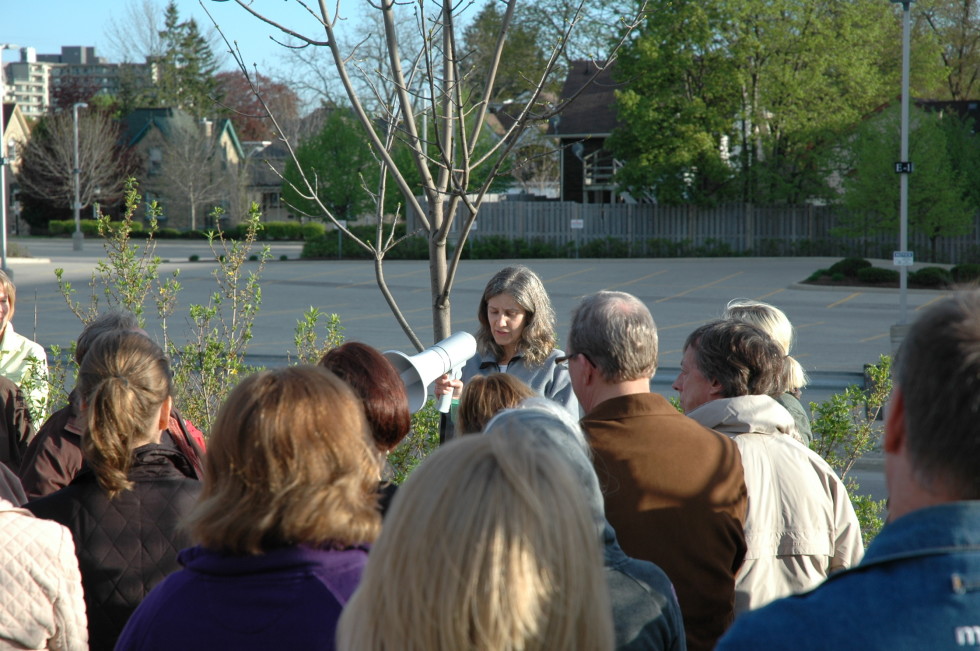
Juanita Metzger sets the stage for the “Community to the Power of 10” Jane’s Walk.
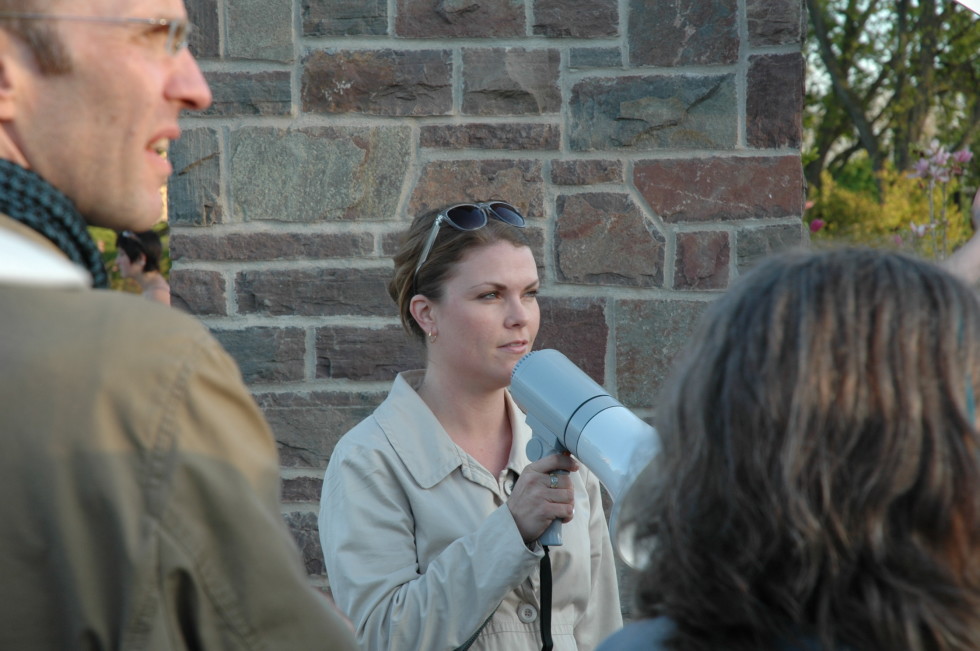
K. Jennifer Bedford talks about Victoria Park from the perspective of someone who lives in the neighbourhood.
What you can’t see in this photo is the scene that played out, over Jennifer’s shoulder, behind the pillar. A group of 10 – 12 youth where in the middle of an escalating argument. It seemed certain that someone was about to be hurt. Somehow, the presence of 70 people, suddenly looking on seemed to diffuse the situation. Jennifer responded to the situation beautifully – who wouldn’t take notice when a megaphone projected voice suddenly competes (and wins) over the shouting argument!
Never a dull moment on our walks!

Bill Rieck also talks about Victoria Park from the perspective of someone who lives in the neighbourhood.

Mark Garner, Executive Director, Kitchener Downtown Business Improvement Association gives a history and tour of Market Lane & the Market area of Downtown Kitchener.
 Friends take a break on the wall entrance to Victoria Park.
Friends take a break on the wall entrance to Victoria Park.

A crowd of 70 people stretches out over a whole block!! But it was always easy to follow the signs.
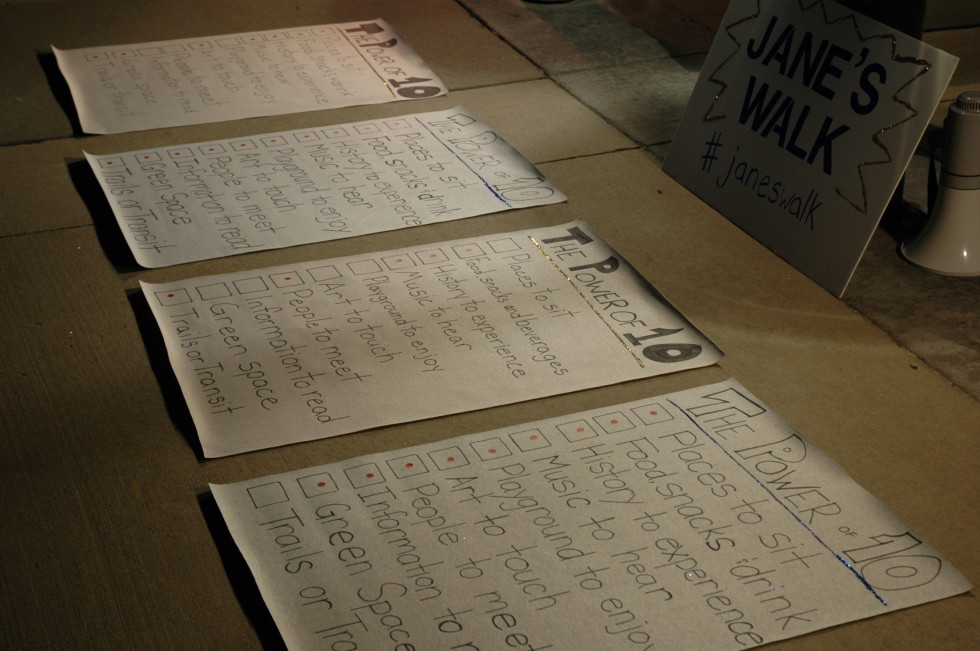
The crowd gets to compare the four places we visited on our Jane’s Walk.
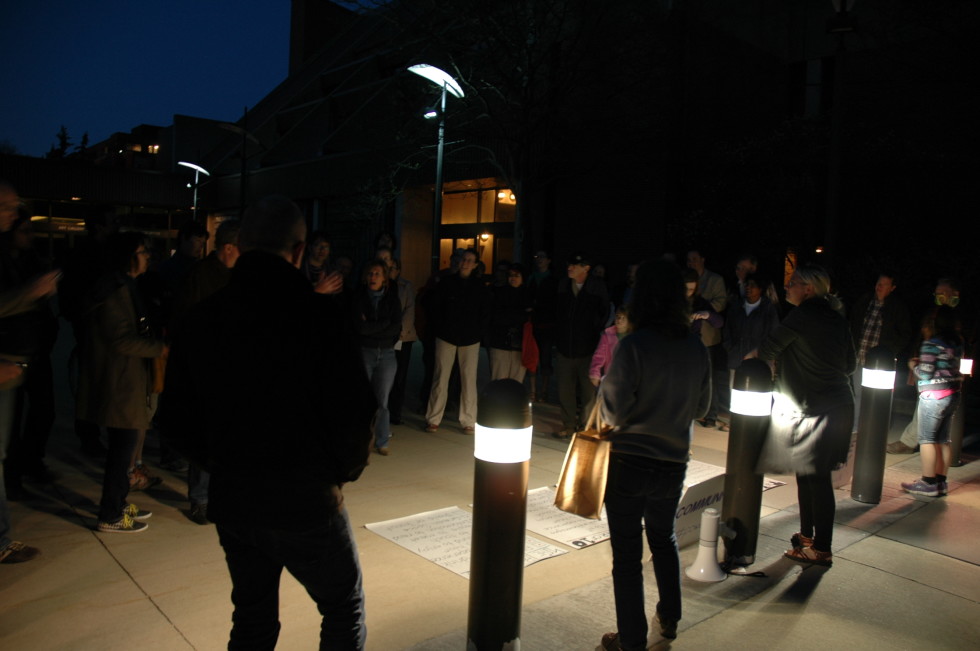
We finished up our Jane’s Walk at the Centre in the Square.
This Jane’s Walk had some real magical moments. Many people felt they had looked at very familiar places with a new perspective. With such a simple tool like “The Power of 10”, many people felt they could easily use the concept to examine and talk about their own street or neighbourhood in a new way.
But the most magical moment came at the end of the walk. As people drifted away in to the night, under the rising super moon, Elif Günçe, a recent immigrant to Canada and Kitchener and a woman I’ve met online and at various community meetings came to tell me how much she enjoyed the walk. Elif and her fiancée, who was visiting from Turkey, decided to come on the walk in order to explore their potential new home community. In fact, Elif and her fiancée were so impressed by the energy, enthusiasm and engagement of the walk participants that they decided, then and there, they would make Kitchener their new home when her fiancée returned to Canada permanently. That’s the power of community in action! Powerful enough that two people would be so inspired by citizen and resident passion for building a vibrant, dynamic, safe and healthy community that they would make it their new home.
Beautiful.
When you get the chance to take a Jane’s Walk next year, take it. You just never know what might happen.
Posted on: October 27th, 2011 by Waterloo Region Crime Prevention Council
Over the past couple weeks, I’ve been writing about placemaking. In part because we just had a fantastic event with Cynthia Nikitin of the Project for Public Spaces, but also because placemaking is a great, ‘smart on crime’, crime prevention tool for neighbourhoods and communities. The Festival of Neighbourhoods in Kitchener, Ontario, is a perfect example of placemaking in action.
Created as a “throw a community party, plan a project and get to know your neighbours” kind of event, the Festival of Neighbourhoods has become a great deal more. That “throw a party” approach has led to strengthened community connections and interactions among neighbours where engaged, everyday people make a difference in their community, every day.
In recent decades, society and technology has changed so much that we now spend less time connecting with each other, face to face, and more time at work, in front of screens, in our cars and in our homes. Getting to know the people who live next door and down the street really can make you happier knowing there are folks close by that you can count on.
In crime prevention the saying goes that “a connected community is a safer community”, which is why we, at the Waterloo Region Crime Prevention Council has sponsored the “Safer Neighbourhood” award at the Festival of Neighbourhoods for the last number of years. The award is for a neighbourhood that hosted an event with the intention of creating a safer community through activities related to community safety, safety awareness and crime-prevention.

Festival of Neighbourhoods – Winners of the Safer Neighbourhood Award
The winner of this year’s “Safer Neighbourhood” award was the Victoria Park Neighbourhood Association for their Henry Sturm Community Festival. The neighbourhood organized a clean up to raise awareness about a neglected, but much loved wooded area along a stretch of the Iron Horse Trail that backs onto many properties in the community. But more importantly, they held a tree planting ceremony in memory of their neighbour who lost his life on New Year’s Eve 2010 on the very same trail behind their houses. It was a chance for family, friends, neighbours and supporters to honour his life and the contributions he made to the neighbourhood which included friendly hellos, a helping hand and time to stop and chat.
This community festival held by a group of caring and committed neighbours is placemaking in fine form. The kind of connections established and maintained within this group will do more for creating a strong sense of place, safety and community than real estate values, fancy design and planned communities could ever do.
Here at the Crime Prevention Council, we have another saying: “Together for a safer community”. We all have a role to play in making and creating safer communities and one way is through building stronger connections with the people who live around us.
What ‘smart on crime’ actions are you taking in your neighbourhood to build connections… and have a little fun?
Posted on: October 12th, 2011 by Smart on Crime
As we all strive to find innovative ways of creating safe communities and reducing crime, sometimes the solutions can be quite astounding. But how do we go about doing this and have an impact? The famous slogan utilized by Nike is a great start – Just do it!
We often spend so much time thinking about these strategies and trying to seek out funding for them that we get sidelined and forget that we are seldom able to achieve great things without the help of others. Another chronic problem we hear about often is there’s not enough capacity. In 2010 I was doing some research on street pianos in New York City. I was truly inspired by Luke Jerram, an artist that had successfully done this and calls the initiative “Play me, I’m yours”. Could this be done in a much colder climate with short summers and unpredictable weather, I asked myself. The answer was overwhelmingly – Yes it can! And so the adventure began with another great summer launch this year in downtown Red Deer, Alberta.

The Ross Street Piano
It’s difficult to imagine having such great success without sharing it and engaging others that can help make a difference in their community. I consider this the key to great community-building initiatives such as the Ross Street Piano project. Local musicians, artists, businesses and residents have all done their part to make this a success. I tell people that it’s music to my ears. When I see the activity and the street “buzz” this has created throughout the summer, I’m further inspired. We don’t always need to reinvent the wheel when many successful initiatives and best practices already exist.
Does having a street piano downtown prevent crime? Well, if you consider the principles of Crime Prevention through Environmental Design, better known as CPTED, yes it does. There is a direct connection between our built environment and the human condition. We interact daily with people in the various spaces we inhabit. When you generate positive activity on the street, it attracts more people. Jane Jacobs wrote “you don’t really get a clear picture until you get out of theory-land and into the streets for a closer look.” This is what I do each and every day and it’s best practices such as CPTED that are preventing crime and supporting a proactive, well-balanced approach.
Our local initiative recently inspired another street piano project in the small community of Cochrane, Alberta. Their piano was placed outside this summer on a busy street next to an ice cream parlor and pie shop. Two criminology students from Mount Royal University in Calgary, with the help of their instructor made this a reality. Randi Boulton, a rising young star attended with me at their launch and played for several hours, entertaining a large crowd of bystanders. The more entertainment and activity we can generate on our streets, the less crime. Events such as this can also be the catalyst for connecting us with each other, a critical aspect of building community and improving quality of life.

Our community piano has now been brought inside for another winter. We’ve found a great new home for it at The Hub, a local arts and culture hotspot where people in our community connect daily. Residents, visitors, clients or anyone wishing to play a tune or two will be welcome to do so every Wednesday morning. Since it’s a local hangout for many talented musicians, I’m sure the Ross Street Piano will not sit quietly this winter and there is already some ideas brewing about the new artwork that will appear on it next summer – stay tuned.
Full story in Red Deer Living Magazine
Author: Steve Woolrich is a crime prevention practitioner based in Red Deer, Alberta and works with communities across North America. Steve is a believer of the ‘walk the talk’ philosophy and spearheaded The Ross Street Piano project with the support of family and friends. It’s truly a labour of love and passion for community. Steve Woolrich also writes his own blog, Target Crime.
Posted on: October 7th, 2011 by Waterloo Region Crime Prevention Council
‘Placemaking’ is fast becoming a new ‘buzz word’. But what does it really mean anyway? It ends in ‘ing’ so that means it’s a verb, which means some kind of action is happening… What kind of action is required to ‘make a place’? And what does ‘making a place’ have to do with crime prevention and being smart on crime?
Well, the good folks at the Project for Public Spaces (PPS) in New York have a lot of experience with ‘placemaking’. In fact, it’s their entire philosophy. To PPS, placemaking is simply an approach for creating and/or transforming safe public spaces (e.g. civic squares, markets, streets, parks & trails, public buildings, transportation, downtown areas, etc). This approach engages community residents and decision-makers in the process and the ultimate purpose is to create spaces and places that are vibrant, dynamic, safe and healthy.
So, why does this matter to crime prevention?
We know from the work of crime prevention through environmental design (CPTED) that people feel uncomfortable or fearful in places and spaces that look and/or feel unsafe or dangerous. There’s a domino effect here – if people don’t feel safe in a public place, people don’t go there. If people don’t go there, most likely the space doesn’t get used for what it was intended. When ‘legitimate’ use of a space doesn’t take place, quite often, less desirable activities will take its place. Placemaking can help to turn a place around.
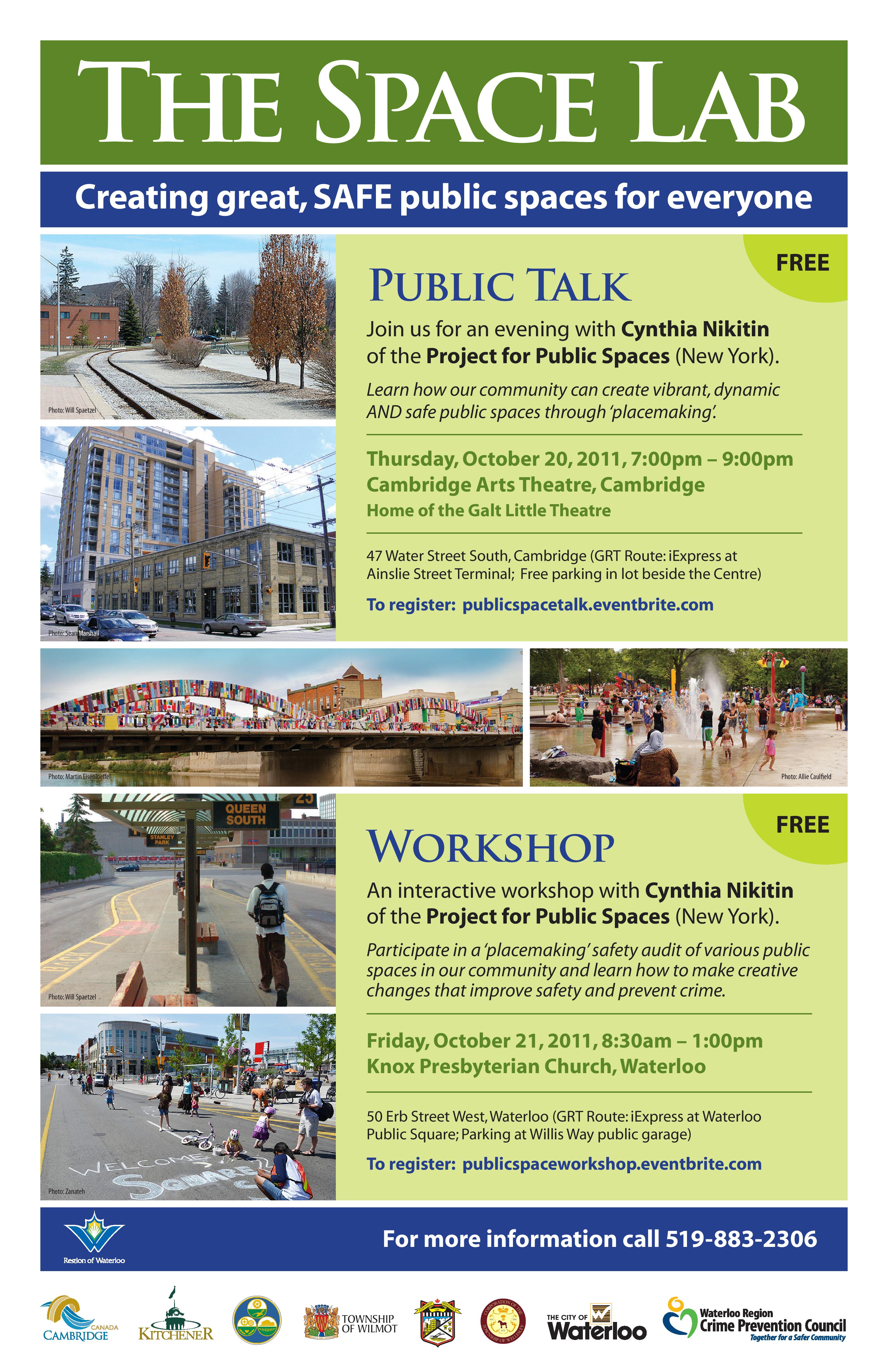
One of our roles as the Waterloo Region Crime Prevention Council (WRCPC) is keep our area municipalities engaged in the very important role they have to play in municipal-based crime prevention. Building on events we’ve done in the past, WRCPC has engaged Cynthia Nikitin from Project for Public Spaces to visit Waterloo Region on October 20 & 21, 2011. Cynthia will present a free public talk and workshop on community safety and crime prevention through placemaking.
You can register here for both events.
So, why does this matter to municipalities?
Municipalities are the closest level of government to the places where we live, work and play. Decisions made at the municipal level have the most direct impact on the public spaces in our neighbourhoods and communities. We know that vibrant, dynamic, safe & healthy public spaces and neighbourhoods play a very important part in community life. They are effective for:
- increasing social interaction and cohesion
- reducing crime and fear of crime
- increasing perceptions of safety
- encouraging legitimate activity & discouraging less desired activity
- developing a sense of ownership among community residents
- improving “liveability” in neighbourhoods
While talking with many people about these events, I’ve heard the same comment several times…. “Wow, I’ve never thought about crime prevention that way before, but it makes total sense!” Smart on crime is all about using evidence-based solutions for challenges facing our communities related to crime, fear of crime and victimization. Placemaking has been proven to work. Often, the best solutions are not the most expensive or the most complicated. The solutions that work are the ones where the community is directly involved in the creating the solution and where the community takes continued ownership for making a place their own.
We’ll be posting several more articles over the next few weeks on the topics of crime prevention, placemaking, public space and community safety. Have you had experiences with placemaking? Good, bad, or otherwise? Tell us your placemaking story.







 Friends take a break on the wall entrance to Victoria Park.
Friends take a break on the wall entrance to Victoria Park.






